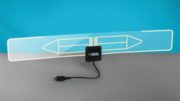Fifty years ago, a TV antenna was a 12-foot-long beast. You can still buy those big ones, but most people can easily get away with a cool-looking, 2-foot wide spaceship like this Televes DigiNova Boss. That’s partially because antenna technology has gotten better, and partially because broadcast technology has improved.
See, you really only need a massive antenna to get those low-numbered channels. With almost all broadcasting moved off the VHF-Low band, most people will never need an antenna that gets channels 2-6. The higher the broadcast channel, the smaller the antenna you need to get it, and that’s the major reason antennas have gotten smaller.
At the same time, we’ve come to understand more about how to design antennas so that it’s easier to create the best ones ever. Those 1950s beasts were designed with nothing but pad and paper, but today we can simulate what tiny changes can do, before the antenna’s ever made. That means antennas that perform better when they’re installed. We’ve also figured out how to eliminate a lot of the signal loss that used to happen with those flat antenna wires and how to amplify signals without adding too much noise.
Right on the face of it, it doesn’t seem like there would be anything left to do. Things are pretty darn good. But then again, they could always get better.
Future design improvements in antennas will depend on one thing: if people want to pay for them. Cord-cutting in the US is still on the rise, and more people than ever find that an antenna suits them just fine. I think we’ll continue to see improvements in small antennas, and I have a feeling there’s a big breakthrough on the horizon.
I think of it like auto design. For decades carmakers concentrated on making cars that sliced through the wind with as little resistance as possible. That was great, but today’s cars do more than slice through… they tailor the airflow around them to cut noise, increase efficiency and make the whole care more stable. They aren’t trying to eliminate airflow, they’re using it to improve the driving experience.
Retired engineers who read this blog are definitely going to tell me I’m wrong, but I think there’s still a mystery to be solved with TV antennas. I think that we’ll find within the next 5-10 years that just by making some tiny change to antenna design, we’ll get antennas that are more sensitive than we ever expected. It will be something totally unexpected that most people would think would never work, but that’s how big discoveries get made. The first antibiotics came from moldy bread and the first nonstick surfaces were the result of a lab accident. Someone will push the wrong button when designing an antenna and all of a sudden things will look very different.
If you buy an antenna today, it’s going to last you for years, maybe even decades if you buy the right one. On the other hand, the next antenna you buy could be 300% better and 50% the size. Who knows?





